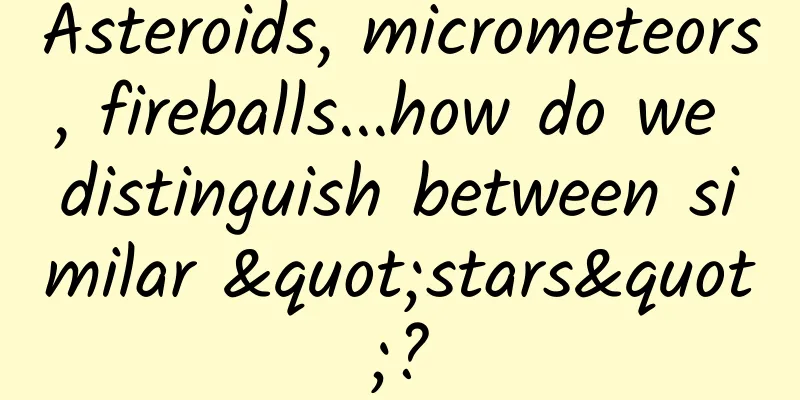Asteroids, micrometeors, fireballs...how do we distinguish between similar "stars"?

|
According to the solar nebula theory, the solar system is a nebula disk composed of dust and gas, which was formed by accretion under the action of gravity. Most of the matter in the solar nebula formed the sun, the eight planets and their satellites and dwarf planets, forming the main structure of the solar system. The remaining "bricks and tiles" scattered in orbit formed the small celestial bodies scattered all over the sky. Figure 1 From the Solar Nebula to the Solar System Small celestial bodies are celestial bodies that orbit the sun and are significantly smaller in size and mass than planets and dwarf planets. Small celestial bodies include asteroids and comets. Comets contain more volatile substances such as water ice, and when they are close to the sun, a bright tail can generally be observed. Figure 2 Asteroids (left) and comets (right) Asteroids and comets with a diameter of less than 1 meter are also called micrometeoroids. Meteors are the luminous phenomena produced by small celestial bodies and micrometeoroids entering the Earth's atmosphere at high speed. Meteor showers are the phenomenon that when a group of meteors encounters the Earth, people will see a significant increase in meteors in a certain area of the sky. The parent body of a meteor shower is generally believed to be a comet. Figure 3 Meteor shower Fireballs are the luminous phenomena produced when a large meteor enters the lower atmosphere and continues to burn without completely burning in the upper atmosphere. Not only are they extremely bright, but sometimes they also make sounds. Meteorites are formed when meteoroids fall on land. Meteorites are an important source of samples for human research on asteroids. Figure 4 Fireball (left) and meteorite (right) In terms of material origin, asteroids, like the eight planets, originated from the solar nebula, so their material composition is basically the same. However, due to their small size, most asteroids have not experienced differentiation, nor weather and geological phenomena such as clouds, rain, volcanoes, and earthquakes. Therefore, most asteroids still retain the original material composition of the early formation of the solar system. The exploration of asteroids is of great significance to the study of major scientific issues such as the origin and evolution of the solar system, the origin of life and water on Earth, etc. Okay, now do you understand the differences and connections between these concepts? |
<<: Special: 30 pictures, farewell to 2023
Recommend
3 Case Studies to Help You Implement Growth Models (Part 1)
With the rapid development of the Internet , its ...
"Saltness Battle": Atlantic Ocean VS Pacific Ocean, the salinity gap is quietly widening!
Produced by: Science Popularization China Author:...
55-inch 4K TV sells for 7999! Is Coocaa T55 a risky move?
How much should an Internet brand TV cost? I beli...
After getting the medicine prescribed at a big hospital, should the community clinic help with the injection?
Recently, there was news that an elderly man was ...
A brief discussion on the rules of Kuaishou live streaming
Amid the epidemic, offline stores are bound to be...
New media writing from 0 to 1, teach you to easily write 100,000+ popular articles [Video Course]
New media writing from 0 to 1, teach you to easil...
Analysis of Tik Tok short video products!
This article mainly analyzes the product developm...
The 14th Honda China Energy Conservation Competition was successfully held
From November 25th to 26th, the 2023 14th Honda C...
How to reduce the size of Android apps
【51CTO.com Quick Translation】I wonder if you have...
Nissan Teana with oil drained caught fire during C-NCAP test, losing its five-star safety title
Fires are common in car accidents due to gasoline...
How was China's grain base built?
Do we need to stockpile food? Do we really not ha...
Why do you feel sore all over when you have a fever? It's actually a sign that your protection is about to be upgraded
Produced by: Science Popularization China Author:...
Three generations of the F-15 family gathered at Nellis Air Force Base to conduct F-15EX combat test missions
From October 18 to 25, 2021, the F-15EX Eagle II ...
Teacher Cai Danjun's "Outline of Reading Dream of the Red Chamber"
Teacher Cai Danjun's "Outline of Reading...
SEO workflow, what are the specific tasks of SEO every day?
SEO optimization is a boring job. Generally, a ne...









